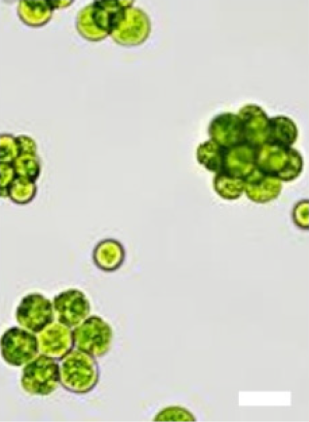
The Chlorophyceae are one of the classes of green algae, distinguished mainly on the basis of ultrastructural morphology. They are usually green due to the dominance of pigments chlorophyll a and chlorophyll b. The chloroplast may be discoid, plate-like, reticulate, cup-shaped, spiral- or ribbon-shaped in different species. Most of the members have one or more storage bodies called pyrenoids located in the chloroplast. Pyrenoids contain protein besides starch. Some green algae may store food in the form of oil droplets. They usually have a cell wall made up of an inner layer of cellulose and outer layer of pectose.
Characiochloris is a genus of green algae in the family Characiochloridaceae. Characiochloris is epiphytic on freshwater algae, or found in soil.
Characiopodium is a genus of green algae in the family Sphaeropleaceae. It occurs in soils.

Chlamydocapsa is a genus of green algae, specifically of the Chlorophyceae.

Neochloris is a genus of green algae in the family Neochloridaceae. It is found in freshwater aquatic and terrestrial soil habitats.
Palmellopsis is a genus of green algae, specifically of the Palmellopsidaceae. They are either planktonic or attached to substrates in fresh water, or in aeroterrestrial habitats.
Polyedriopsis is a genus of green algae in the order Sphaeropleales. As of February 2022, it contained a single species, Polyedriopsis spinulosa. It is found worldwide in freshwater habitats as phytoplankton, but is rare.
Pseudoschroederia is a genus of green algae in the family Characiaceae. It is planktonic in freshwater habitats, and probably has a cosmopolitan distribution. The genus Pseudoschroederia was circumscribed by Eberhard Hegewald and Eberhard Schnepf in 1986. The genus was distinguished from the similar Schroederia by being heteropolar and differing cell structure. However, some authors do not consider the genera to be separate.

Schroederia is a genus of green algae in the family Schroederiaceae. Schroederiaceae is a monotypic taxon; Schroederia is its only genus.

Sorastrum is a genus of green algae in the family Hydrodictyaceae. It is a component of the phytoplankton of freshwater ponds, lakes, and ditches. Sorastrum is common in tropical to temperate regions of the world, but due to its small size it is often overlooked.
Tetracystis is a genus of green algae, in the family Chlorococcaceae. It is a terrestrial genus typically found in soils.

Actinochloridaceae is a family of green algae, in the order Chlamydomonadales.

Deasonia is a genus of green algae, in the family Actinochloridaceae. It is found in soils.

Actidesmium is a small genus of green algae in the family Characiaceae. It was described by the German phycologist Paul Friedrich Reinsch in 1875.
Characiellopsis is a genus of green algae in the family Characiaceae. Two species are known: Characiellopsis anophelesii and Characiellopsis skujae.
Deuterocharacium is a genus of green algae in the family Characiaceae. It is found in freshwater habitats, attached to algae or detritus. It is rare and has only been recorded from Europe.
Korshikoviella is a genus of green algae in the family Characiaceae.

Chlorokybus is a multicellular (sarcinoid) genus of basal green algae or charophyte. It has been classified as the sole member of the family Chlorokybaceae, which is the sole member of the order Chlorokybales, in turn the sole member of the class Chlorokybophyceae. It grows on soil and rock surfaces, and is rare.

Apiocystis is a genus of algae belonging to the family Tetrasporaceae. It is found attached to freshwater aquatic algae or plants. The species of this genus are found in Europe and Northern America, and are widespread but generally uncommon.

Chlorangiella is a genus of microscopic green algae, the type genus of the family Chlorangiellaceae. The name Chlorangiella was coined by Giovanni Battista de Toni in 1889. It is a nomen novum for Chlorangium F.Stein.










